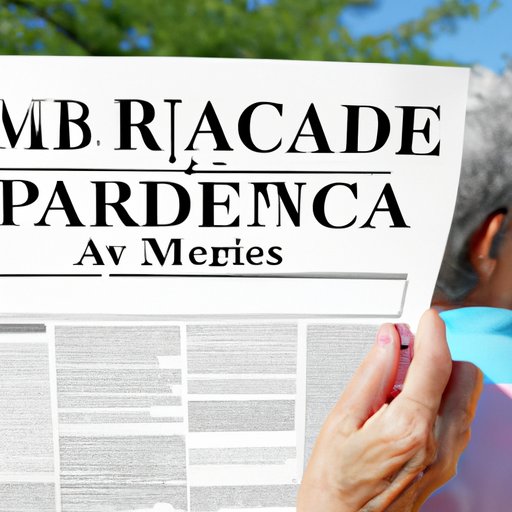Introduction
Medicare is a federal health insurance program that provides coverage for people over 65 and those with certain disabilities. Medicare Part A is one of four parts of Original Medicare, which also includes Part B, Part C, and Part D. This article will provide an overview of Medicare Part A and explain what is covered, eligibility requirements, and costs associated with the plan. It will also compare Medicare Part A to other health coverage options.
Explaining the Basics of Medicare Part A
Medicare Part A is hospital insurance that helps cover inpatient care in hospitals and skilled nursing facilities. It also covers home health care services and hospice care.
What is Medicare Part A?
Medicare Part A is a type of health insurance that helps pay for inpatient care in hospitals, skilled nursing facilities, home health care, and hospice care. It is one of four parts of Original Medicare, which is provided by the federal government. The other three parts are Part B (medical insurance), Part C (Medicare Advantage plans), and Part D (prescription drug coverage).
Who is Eligible for Medicare Part A?
Most people who are 65 or older, or who have certain disabilities, are eligible for Part A. People who have worked and paid taxes into the Social Security system for at least 10 years may be eligible for premium-free Part A. Those who do not meet this requirement may still be eligible for Part A with a premium.
Understanding What is Covered Under Medicare Part A
Medicare Part A helps cover inpatient care in hospitals and skilled nursing facilities, as well as home health care and hospice care. It does not cover routine vision or dental care, hearing aids, eyeglasses, or private-duty nursing.
Inpatient Care
Part A helps cover inpatient care in hospitals, including semi-private rooms, meals, general nursing, drugs, and other hospital services and supplies. It also helps cover inpatient care in skilled nursing facilities, including semi-private rooms, meals, skilled nursing care, and other services and supplies.
Skilled Nursing Facility Care
Part A helps cover skilled nursing facility care if you need daily skilled care after a hospital stay of at least three days. It covers semi-private rooms, meals, skilled nursing care, and other services and supplies.
Home Health Care
Part A helps cover home health care services, such as visits from nurses, physical therapists, and other medical professionals. It also helps cover equipment, such as wheelchairs and walkers, and supplies, such as bandages and catheters.
Hospice Care
Part A helps cover hospice care for people with a terminal illness. It covers inpatient respite care, home health aide services, medical equipment, and supplies related to the terminal illness.

Outlining the Eligibility Requirements for Medicare Part A
To be eligible for Medicare Part A, you must be 65 or older, or have certain disabilities. You must also meet certain work history and residency requirements.
Age Requirements
You must be 65 or older to be eligible for Medicare Part A. If you are under 65, you may be eligible if you have certain disabilities or end-stage renal disease.
Work History Requirements
People who have worked and paid taxes into the Social Security system for at least 10 years may be eligible for premium-free Part A. Those who do not meet this requirement may still be eligible for Part A with a premium.
Other Eligibility Requirements
In addition to age and work history requirements, you must also meet certain residency requirements to be eligible for Medicare Part A. You must be a U.S. citizen or permanent resident who has lived in the U.S. for at least five years.

Exploring the Benefits of Medicare Part A
Medicare Part A provides access to quality health care and financial assistance with medical bills. It can help cover expenses related to hospital stays, skilled nursing facility care, home health care, and hospice care.
Access to Quality Health Care
Medicare Part A helps provide access to quality health care. It covers inpatient care in hospitals, skilled nursing facility care, home health care, and hospice care.
Financial Assistance with Medical Bills
Part A can help cover the costs associated with hospital stays, skilled nursing facility care, home health care, and hospice care. This can provide financial relief to those who need medical care but cannot afford it.
Discussing the Costs Associated with Medicare Part A
Medicare Part A has premiums, deductibles, and coinsurance. Those who qualify for premium-free Part A do not have to pay premiums, but they must still pay deductibles and coinsurance.
Premiums
Most people who qualify for Part A do not have to pay a premium, but those who do not qualify for premium-free Part A must pay a monthly premium. The amount of the premium depends on your work history.
Deductibles
Those who qualify for Part A must pay a deductible for each benefit period. The amount of the deductible varies depending on the type of care received.
Coinsurance
After you meet your deductible, you are responsible for paying coinsurance for any additional care received. The amount of coinsurance varies by type of care.

Analyzing the Pros and Cons of Medicare Part A
Medicare Part A offers some advantages, but there are also drawbacks to consider.
Pros
Medicare Part A provides access to quality health care and financial assistance with medical bills. It can help cover expenses related to hospital stays, skilled nursing facility care, home health care, and hospice care.
Cons
The main downside of Medicare Part A is that it does not cover all types of care. It does not cover routine vision or dental care, hearing aids, eyeglasses, or private-duty nursing.

Comparing Medicare Part A to Other Health Coverage Options
When considering health coverage options, it is important to compare Medicare Part A to other options, such as private insurance and Medicaid.
Private Insurance
Private insurance plans typically offer more comprehensive coverage than Medicare Part A, including coverage for routine vision and dental care, hearing aids, eyeglasses, and private-duty nursing. However, private insurance plans are often more expensive than Medicare Part A.
Medicaid
Medicaid is a health coverage program for low-income individuals and families. It covers many of the same services as Medicare Part A, including inpatient care, skilled nursing facility care, home health care, and hospice care. It also covers some services that Medicare Part A does not, such as long-term care and prescription drugs.
Conclusion
Medicare Part A is a type of health insurance that helps pay for inpatient care in hospitals, skilled nursing facilities, home health care, and hospice care. To be eligible for Part A, you must be 65 or older, or have certain disabilities. It provides access to quality health care and financial assistance with medical bills. There are premiums, deductibles, and coinsurance associated with Part A. When considering health coverage options, it is important to compare Medicare Part A to other options, such as private insurance and Medicaid.
(Note: Is this article not meeting your expectations? Do you have knowledge or insights to share? Unlock new opportunities and expand your reach by joining our authors team. Click Registration to join us and share your expertise with our readers.)
